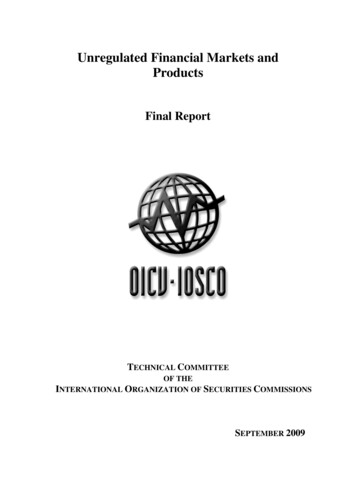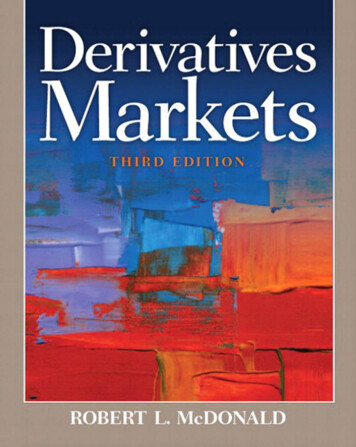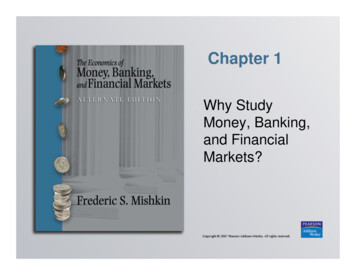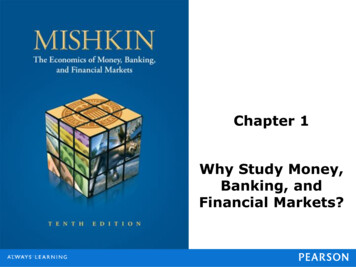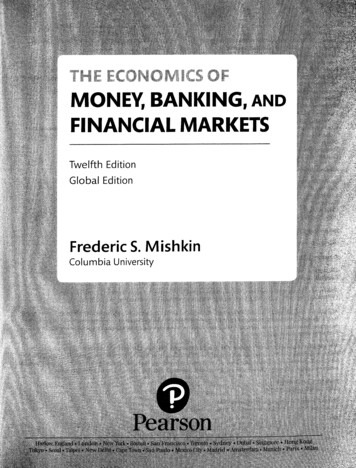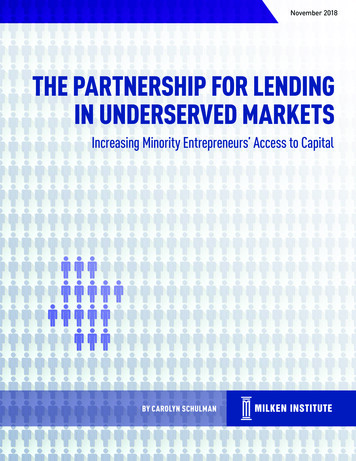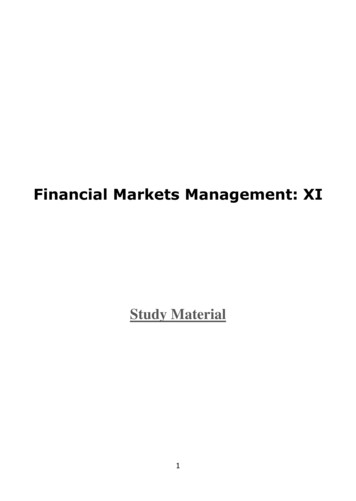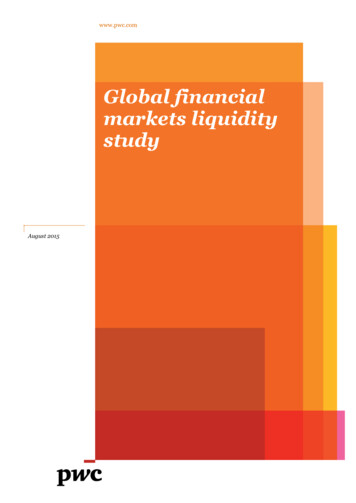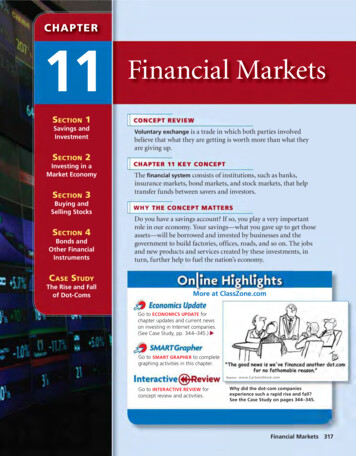
Transcription
CHAPTER11Financial MarketsS ECTION 1CONCEPT REVIEWSavings andInvestmentVoluntary exchange is a trade in which both parties involvedbelieve that what they are getting is worth more than what theyare giving up.S ECTION 2Investing in aMarket EconomyS ECTION 3Buying andSelling StocksS ECTION 4Bonds andOther FinancialInstrumentsC H A P T E R 11 K E Y C O N C E P TThe financial system consists of institutions, such as banks,insurance markets, bond markets, and stock markets, that helptransfer funds between savers and investors.W H Y T H E C O N C E P T M AT T E R SDo you have a savings account? If so, you play a very importantrole in our economy. Your savings—what you gave up to get thoseassets—will be borrowed and invested by businesses and thegovernment to build factories, offices, roads, and so on. The jobsand new products and services created by these investments, inturn, further help to fuel the nation’s economy.C ASE STUDYThe Rise and Fallof Dot-ComsMore at ClassZone.comGo to ECONOMICS UPDATE forchapter updates and current newson investing in Internet companies.(See Case Study, pp. 344–345.)Go to SMART GRAPHER to completegraphing activities in this chapter.Source: www.CartoonStock.comGo to INTERACTIVE REVIEW forconcept review and activities.Why did the dot-com companiesexperience such a rapid rise and fall?See the Case Study on pages 344–345.Financial Markets 317
SECTION1Savings and InvestmentOBJECTIVESKEY TERMSTA K I N G N O T E SIn Section 1, you willsavings, p. 318investment, p. 318financial system, p. 318financial asset, p. 319financial market, p. 319financial intermediary, p. 319mutual fund, p. 320capital market, p. 322money market, p. 322primary market, p. 322As you read Section 1, completea hierarchy diagram to track mainideas and supporting details.Use the Graphic Organizer atInteractive Review @ ClassZone.com identify what constitutes thefinancial system describe the various financialintermediaries explain how economistscategorize the various marketswhere financial assets are soldSavings andInvestmentsmain ideamain ideamain ideadetailsdetailsdetailssecondary market, p. 322The Financial SystemKE Y CON CE P T SQUICK REFERENCESavings is income notused for consumption.Investment is theuse of income todaythat allows for a futurebenefit.The financial systemis all the institutionsthat help transfer fundsbetween savers andinvestors.Find an update on savingat ClassZone.com318 Chapter 11There are two things you can do with your money—spend it or save it. Savings isincome not used for consumption, in other words not spent on immediate wants.Savings that are put to use are investments. In general, investment is the use ofincome today in a way that allows for a future benefit. More specifically, economicinvestment refers to money lent to businesses—to finance the construction of a newfactory, for example. Personal investment refers to the act of individuals putting theirsavings into financial assets, such asCDs, stocks, bonds, or mutual funds.Consider what happens whenyou put money in a savings account.Through this act, you benefit—yoursavings account earns interest—butothers do too. By saving, you makefunds available for the bank to lend.Borrowers use these funds for manypurposes, such as investing in newbusinesses or in new equipment forestablished businesses. The financialsystem, which consists of institutionssuch as banks, insurance markets,bond markets, and stock markets,allows for this transfer of fundsATM Deposits Using an ATM to make deposits makesbetween savers and investors.saving easy and convenient.
F I G U R E 11.1The Financial mercial BanksSavings and LoansCredit UnionsFinance CompaniesLife Insurance CompaniesMutual FundsPension Fundsinterest ANALYZE CHARTS1. What do savers get in exchange for the funds they deposit with financial intermediaries?2. Why do you think that financial intermediaries perform their vital function? Think back toChapter 10 if you need help.Bringing Savings and Investment TogetherIndividuals and businesses can save surplus funds in many ways, including savingsaccounts at commercial banks or S&Ls, certificates of deposit (CDs), corporate orgovernment bonds, and stocks. The agent receiving these funds is a borrower, whoissues savers written confirmation of the transaction. This written confirmation iscalled a financial asset, or a claim on the property of the borrower.Sometimes savers and borrowers come together directly in a financial market,a situation in which buyers and sellers exchange particular types of financial assets.For example, an individual or business might buy corporate bonds or shares of stock.More often, however, financial intermediaries bring savers, borrowers, and financialassets together. A financial intermediary is a financial institution that collects fundsfrom savers and then invests these funds in loans and other financial assets. Figure11.1 shows how funds flow from savers to investors through the financial marketsand financial intermediaries that make up the financial system.AP P LIC AT IONQUICK REFERENCEA financial asset is aclaim on the property ofthe borrower.A financial market iswhere buyers and sellersexchange financial assets.A financial intermediary is an institutionthat collects funds fromsavers and invests thefunds in financial assets.Applying Economic ConceptsA. Look again at the example opposite of a person depositing money into a savingsaccount. How is this an example of Adam Smith’s “invisible hand”?Financial Markets 319
Financial IntermediariesKE Y CON CE P T SQUICK REFERENCEA mutual fund is aninvestment companythat gathers money fromindividual investors andpurchases a range offinancial assets.Financial intermediaries bring savers and investors together. In Chapter 10, youlearned about one group of financial intermediaries—commercial banks, S&Ls,and credit unions. These financial institutions take in deposits from savers and provide loans to individuals and businesses. Many offer other financial assets as well.Other common financial intermediaries include finance companies, whichmake small loans; pension funds, which invest money for groups of workers; andlife insurance companies, which invest funds collected from policyholders. A mutualfund is a pool of money managed by an investment company that gathers moneyfrom individual investors and purchases a range of financial assets. Investors ownshares of the entire fund based on the amount of their investment. These institutions gather their money in different ways and provide many different financialassets to a variety of investors.E X A MP L EThe New York StockExchange Stocks arean important element ofthe assets that make up amutual fund.Banking Financial IntermediariesThis group of financial intermediaries includes commercial banks, S&Ls, and creditunions. All of these institutions provide checking and savings accounts. Depositorsearn interest on their savings deposits and some checking deposits. Most also offerCDs and money market deposit accounts that pay slightly higher rates of interest.(Figure 11.2 explains how savers earn money from interest.) The federal government insures deposits, including CDs and money market accounts, up to 100,000per depositor in any given bank.These institutions lend a portion of their deposits to borrowers. Bankscharge borrowers a higher rate of interest than they pay to savers and hope toearn a profit. The loans are financial assets to the bank. If a borrower does notpay back the loan on time, the bank may repossess the property, such as a homeor a car.Deregulation has allowed banks to offer other financial assets, such asmoney market mutual funds, stocks, bonds, and insurance. The federal government does not insure funds invested in these financial assets.E X A MP L ENonbank Financial IntermediariesThis group of financial intermediaries includes finance companies, mutualfunds, pension funds, and life insurance companies. Finance companies makeloans to households and small businesses. Generally, the loans are under 2,000and are paid back in monthly installments, including interest, over a few years.A mutual fund pools money from many personal investors. In return,each investor receives shares in a fund that is made up of a large number andvariety of stocks, bonds, or other financial assets. Mutual funds make it easierand more affordable for individual investors to own a wide variety of financialassets. Once investors purchase shares of a fund, they allow its managers tomake investment decisions.320 Chapter 11
Pension funds allow employees to save money for retirement and sometimesinclude contributions from employers. The pension fund then invests these pooledcontributions in various financial assets that will increase in value and provideworkers with more money when they retire.Life insurance companies allow individuals to accumulate savings by buildingcash values and protect against losses from death or disability. Just as banks lend someof their deposits, insurance companies lend or invest some of the income earned frompolicyholders in a variety of financial assets.M AT H C H A L L E N G EF I G U R E 11. 2Calculating InterestBanks pay savers interest in order to use their money. A saver’s initial deposit iscalled the principal. Simple interest is the interest paid on the principal alone.Compound interest is paid on the principal plus any earned interest. The followingsteps show how an annual rate of 5 percent interest is paid on the principal ( 1,000)over three years.Year 1 Simple interest is calculated using the following formula:PrincipalⴛInterestrate Interestearnedⴛ 1,000.05 50.00Year 2 The amount in this account is now 1,050.00. Compound interest, which ispaid on the principal plus the earned interest, is calculated as follows:(Principal Year 1 interest)ⴛInterestrate Interestearned( 1,000.00 50.00)ⴛ.05 52.50.05 55.13Year 3 There is now 1,102.50 in the account. Interest continues to compound.(Principal Year 1 interest Year 2 interest)ⴛInterestrate Interestearned( 1,000.00 50.00 52.50)ⴛAfter three years, the total in the account is 1,157.63.Using a Formula Instead of using the multiple steps shown above, youcan calculate the total value of an account using the following formula(wherein P principal, r interest rate, and t number of years):P(1 r) t AP P LIC AT IONtotal value 1,000.00(1 .05) 3 1,157.63NEED HELP ?Math Handbook,“Calculating CompoundInterest,” page R6Comparing and ContrastingB. How is a pension fund like a savings account? How is it different?Financial Markets 321
Financial Asset MarketsKE Y CON CE P T SQUICK REFERENCEThe capital market iswhere long-term financialassets are bought and sold.The money market iswhere short-term financialassets are bought and sold.The primary market isfor buying financial assetsdirectly from the issuer.The secondary marketis where financial assetsare resold.The different financial assets discussed in this section are bought and sold onvarious financial markets. Economists tend to categorize these markets based ontwo factors—time (how long the loan is for) and whether the financial assets canbe resold. Based on time, economists distinguish between the capital market, themarket for buying and selling long-term financial assets, and the money market, themarket for buying and selling short-term financial assets. In regard to resalability,economists distinguish between the primary market, which is the market for buyingnewly created financial assets directly from the issuing entity, and the secondarymarket, which is the market where financial assets are resold.FA CT OR 1TimeThere are two time-sensitive markets. Capital markets are markets where assets are held for longerthan a year. Some examples of assets sold on thecapital market include certain kinds of securities,namely stocks and bonds, mortgages, and longterm CDs. Because these loans are for longer periods of time, the money may be invested in projectsthat require large amounts of capital, such as buying homes, building new factories, retooling established factories, or financing government projects.Money markets are markets where loans areReturn on Investment Time is anmade for less than a year. Examples of assets tradedimportant factor in the level of return forin these markets include short-term CDs that deposmany investments.itors can redeem in a few months and Treasury bills,which allow the U.S. government to borrow money for short periods of time.FA CT OR 2ResalabilityThere also are two kinds of markets based on whether the financial assets can beresold. Primary markets are markets for financial assets that can be redeemed onlyby the original buyer. Examples include savings bonds and small denomination CDs.The term primary market also refers to the market where the first issue of a stock issold to the public through investment bankers.Secondary markets are resale markets for financial assets. These markets offerliquidity to personal investors. So, investors are able to turn their assets into cashrelatively quickly. Stocks and bonds, which you’ll learn more about later in this chapter, are two of the most prominent financial assets sold on the secondary market.A P P L ICAT IONAnalyzing EffectsC. Why are stocks and bonds part of the capital market and the secondary market?322 Chapter 11
SECTION1AssessmentClassZone.comE C O N O M I C S I N P R AC T I C EREVIEWING KEY CONCEPTS1. Explain the difference between the terms in each of these pairs.a. savingsinvestmentb. capital marketmoney marketc. primary marketsecondary market2. What is the purpose of the financial system?3. Why do banks receive financial assets when they make loans?4. How does a mutual fund serve as a financial intermediary?5. What determines whether a loan is part of the capital market or themoney market?6. Using Your Notes What is therelationship between financialintermediaries and the financialsystem? Refer to your completedhierarchy diagram.Savings andInvestmentsStock certificatesmain ideamain ideamain ideadetailsdetailsdetailsUse the Graphic Organizer at Interactive Review @ ClassZone.comCRITICAL THINKING7. Categorizing Information Which of the following are bankingfinancial intermediaries and which are nonbanking financialintermediaries? Consumer Finance Company Investors’ Mutual Fund Family Life Insurance Company Employee Credit Union First National Bank Employee Pension Fund Home Savings and Loan8. Making Inferences A local bank offers savings accounts thathave no minimum balance requirement and pay 3 percent interestper year. Account holders can withdraw any amount of moneyfrom their accounts at any time. The bank also offers moneymarket accounts that require a 500 minimum balance and pay4 percent interest each year. Account holders are allowed twowithdrawals per month, but each must be for at least 100. Whydoes the money market account pay a higher interest rate?9. Applying Economic Concepts Suppose that you deposit 100into your savings account, which earns 3 percent interest per year.Use what you’ve learned about calculating interest to determinehow much money you’ll have in your account at the end of oneyear and at the end of six years.10. Challenge Why might a decrease in household savings have anadverse effect on small businesses in a local community?Identifying MarketsConsider how economists categorizefinancial markets. Copy the tableshown below. Review the bulleted listof financial assets and place each onein the correct location(s) in the table.Assets may be placed in more thanone category. 15-year mortgage6-month CD for 1,0002-year CD for 25,0005-year corporate bond10-year savings bondShares of stock26-week Treasury bill30-year Treasury bondCapital MarketMoney MarketPrimary MarketSecondaryMarketChallenge Why do savings bondsand small certificates of deposit haveless liquidity than shares of stock?Financial Markets 323
SECTION2Investing in aMarket EconomyOBJECTIVESKEY TERMSTA K I N G N O T E SIn Section 2, you willinvestment objective, p. 324 discuss the issues that shouldbe considered when makinginvestment decisionsrisk, p. 327As you read Section 2, complete achart like the one shown using thekey concepts and other helpfulwords and phrases. Use theGraphic Organizer at InteractiveReview @ ClassZone.comreturn, p. 327diversification, p. 327 explain how risk and return arerelatedInvesting in a Market Economyobjectivesrisk vs. returnWhy Are You Investing?KE Y CON CE P T SQUICK REFERENCEAn investmentobjective is a financialgoal used to determineif an investment isappropriate.In Section 1, you saw that there are two types of investing: personal and economic.Note that for the remainder of the chapter, we’ll be using all forms of the word investas a quick way to refer to personal investing—which is, in effect, saving.You’ve now learned that there are a number of assets you can own. But how doyou determine which is, or are, right for you? The first thing that you might do is todecide why you are investing. This reason is your investment objective, a financial goalthat an investor uses to determine if aninvestment is appropriate. Some possible financial goals are saving moneyfor retirement, for a down payment ona house or an automobile, for collegetuition, or for a vacation. Your goal helpsyou to determine the right investments.Investment ObjectivesTwo issues play a major role in determining which investments work bestto achieve different investment objectives. The first issue is time. For example, is this a short-term financial goal,such as saving for a vacation, or a longterm financial goal, such as saving for324 Chapter 11Savings Goals Saving for a car down paymentsuggests certain kinds of longer-term investments.
YO U R EC O N O M I C C H O I C E SINVESTM ENT OB J EC TIVESWhat reasons do you have for investing?Do you have any investment objectives?Maybe you have a short-term objective, suchas saving money to go on spring break. Oryour objective is more long term, such assaving for college. What kinds of investmentsmight be appropriate for your objective?Saving for vacationSaving for collegeretirement? The amount of time you have to build your savings influences the kindsof investments that would be most appropriate.The second issue is income. How much money do you have available to save aftermeeting current expenses? The answer to this question is influenced by a series ofother questions: Will your income change in the future? Is there money available foremergencies? To respond to all these questions, having a savings plan that is realisticand that is flexible enough to adjust to changing circumstances can be a big help.Other important questions are: Do you have any outstanding debts? Are youpaying taxes on time? Paying off debts is an important first step to investing. Generally, the interest you pay on debts, such as credit card balances, is higher than whatyou can earn through most investments. Tax considerations are most important forinvestors with higher incomes who are subject to higher tax rates.Different types of investments are suitable to various investment objectives. Forexample, savings for emergencies should be in highly liquid investments, such assavings accounts or money market accounts. With these investments, the risk ofloss is low and money can be withdrawn at any time. Saving for a vacation wouldalso require investments that are short-term and liquid. Investors who are saving forlonger-term goals may be less concerned with immediate liquidity and may want toinvest in stocks that increase in value over a longer period of time. CDs that commitfunds for a certain length of time may be chosen to coincide with the timing of certain savings goals, such as making a major purchase or starting college. Many bondsoffered by state and local governments offer tax-free earnings.AP P LIC AT IONFind an update oninvesting atClassZone.comDrawing ConclusionsA. Would a CD be a more appropriate way to save for a down payment on a car or foremergencies? Why?Financial Markets 325
ECO N O M I C S PAC ES E T T E RMellody Hobson:Investing in the FutureFAST FACTSMellody HobsonTitle: President of ArielWhat do the Chicago Bulls, hip-hop stars, and inner-city elementary school students have in common? All are part of Mellody Hobson’s efforts to get investment“discussed around every dinner table.” Hobson believes that many people lack thenecessary knowledge to determine their investment objectives and manage theirmoney to create wealth. How is she trying to change this situation?Capital Management, LLCBorn: April 3, 1969,Chicago, IllinoisMajor Accomplishment: Educates millionsof people about thebenefits of investing.Ariel’s Assets UnderManagement: 21.3billion (2005)Other Roles: Financialcontributor to GoodMorning America on ABCBoard Member:Chicago Public Library,the Field Museum, theChicago Public EducationFund, and the SundanceInstituteDirector: DreamWorksAnimation SKG, Inc., theEstée Lauder CompaniesInc., and StarbucksCorporationFind an update onMellody Hobson atClassZone.comCreating Educated InvestorsMellody Hobson discovered her career in investing as a college intern. When she gother degree in 1991, Hobson landed a position in the marketing department at ArielCapital Management LLC. In 2000, she became the president of the company, makingher the most powerful African-American woman in the mutual-fund industry. Aspresident of Ariel, Hobson runs an operation with over 21 billion in assets.Ariel was the first minority-owned mutual fund company in thecountry and pioneered programs to teach inner-city schoolMellody Hobsonchildren about investing. Hobson’s passion for investmenteducation led her to give presentations in locations fromPTA meetings to union halls. She developed the first ongoingstudy of investing by African Americans and looked forways to increase their participation in the stock market.“The stock market represents a major source of wealthcreation in this country,” Hobson has stated, “but . . . AfricanAmericans have been largely left out.” Ariel’s marketing effortsto the black community included cosponsoring events withthe Chicago Bulls and creating a stock-picking contestinvolving well-known hip hop stars.When Hobson became the financial contributorto the Good Morning America television programin 2000, she was able to reach millions of peoplewith easy-to-understand information about economic matters. Hobson believes that more knowledge about the benefits of investing in stocks andgreater diversity in the investment industry willhelp bring the benefits of investing to people of allracial and economic backgrounds.A P P L ICAT IONMaking InferencesB. Why might Mellody Hobson thinkit is important for families to talkabout investing at the dinnertable?326 Chapter 11
Risk and ReturnKE Y C ONCE P T SOnce investors have decided their financial objectives, there are two other relatedissues they might consider—risk and return. Risk is the possibility for loss on aninvestment, and return is the profit or loss made on an investment.While savings deposits in banks are insured against loss, most investmentscarry some possibility of losing part of the money invested. Return may refer tothe interest paid on a savings account or CD or the increase in value of a stock overtime. Most investors try to balance risk and return through diversification, thepractice of distributing investments among different financial assets to maximizereturn and limit risk.QUICK REFERENCERisk is the possibility forloss on an investment.Return is profit or lossmade on an investment.Diversification is thepractice of distributinginvestments amongdifferent financial assets.What Kind of Risk Are You Willing to Take?RiskWhen most investors think about risk, they think about the possibility of losingsome of their initial investment, often referred to as their principal. Even if theydon’t earn a lot of money on the investment, they want to get back at least whatthey put in. Investments that guarantee no loss of principal include insured savingsdeposits and CDs. Bonds that are backed by the U.S. government are also consideredto be almost risk-free because it is highly unlikely that the government would notpay back its loans. Almost all other investments carry some risk.One of the biggest risks investors face, even with safe investments like thosedescribed above, is loss of the purchasing power of the money invested due to inflation. (Remember that inflation is a general rise in the level of prices.) That is whymany financial advisers warn against investing everything in safe investments thatpay a guaranteed rate of interest that may not keep up with inflation.Other investments, such as stocks and corporate bonds, carry a higher degree ofrisk because the return depends on how profitable the company is. Investors who purchase stock with the expectation that it will appreciate in value over time may lose someof their money if the comFIGURE 11. 3 THE REL AT IONSHI P OF R ISKpany runs into problems orAND RE TURNother economic factors affectthe value of the stock. In thatcase, investors may find thatthey cannot sell the stock foras much as they paid for it,and they suffer a loss. Investors in corporate bonds facesimilar risks, although bondsare considered less risky thanstocks because creditors suchas bondholders are paid offbefore stockholders if a company has financial problems.ReturnRisk and ReturnRisk and return have adirect relationship—thehigher the risk of theinvestment, the greater thepossible return.Financial Markets 327
YO U R EC O N O M I C C H O I C E SRISK AND R ETU RNHow can you balance risk and return?When you consider what financial assets further your investment objective,you must address both risk and return. A high-risk investment may bring largereturns, but can you absorb the potential losses? A low-risk investment mayprovide a steady return, but because ofinflation you may be losing money. How wouldyou decide which type of investment to make? ReturnRiskWhat Kind of Return Do You Want?When making investment decisions, investors estimate what kind of return theyexpect to earn. The safest investments, such as Treasury bills, interest-bearing savings accounts, and shorter-term CDs, generally offer the lowest return in the form offixed rates of interest. The returns on stocks and bonds are not guaranteed and mayvary considerably at different times, depending on how the company you invest inperforms and the state of the economy as a whole. Generally, stocks provide a higherreturn over time than do other investments.As Figure 11.3 on page 327 shows, risk and return are directly related—thegreater the possible return, the higher the risk that the investment will lose value.Investors always want the highest return possible, but they must balance that desirewith a realistic understanding about the level of risk they can tolerate. The factors oftime and income come into play here. People who are investing for retirement over aperiod of 20 to 30 years may be willing to take more risk by investing in stocks becausetheir investments are likely to increase over that period, even though they mighthave losses in some years. People with less time and less income to invest might notbe willing to risk possible losses.Diversification is the most common way for investors to maximize their returnsand limit their risks. For example, you might put 70 percent of your investmentsfor retirement in a variety of stocks, 20 percent in bonds, and 10 percent in CDs. Byspreading out your money in a variety of assets, you have a better chance of offsettinglosses from one investment with gains from another. Mutual funds, which invest ina large number of stocks or bonds, help small investors diversify their investments.A P P L ICAT IONDrawing ConclusionsC. Is it possible to have a low-risk, high-return investment? Why or why not?328 Chapter 11
SECTION2AssessmentClassZone.comE C O N O M I C S I N P R AC T I C EREVIEWING KEY CONCEPTS1. Use each of the three terms below in a sentence that illustrates themeaning of the term:a. investment objectiveb. returnc. diversification2. What is the relationship between risk and return?3. How would the risk of investing in a single stock compare with therisk of investing in a mutual fund? Why?4. How is diversification related to risk and return?5. How are risk and return related to investment objectives?6. Using Your Notes How dotime and income influenceinvestment objectives? Refer toyour completed chart.Investing in a Market Economyobjectivesrisk vs. returnUse the Graphic Organizer atInteractive Review @ ClassZone.comCRITICAL THINKING7. Comparing and Contrasting Matthew’s parents started savingfor his college education when he was born. When Matthewturned 16, he got a part-time job and saved part of his earningsfor his college expenses. Compare and contrast the investmentobjectives of Matthew and his parents and describe the factorsthat influenced their investment decisions.8. Drawing Conclusions Ryan owns shares in a single mutual fundthat includes stocks and bonds. Maggie invests her money inTreasury bonds, state bonds, and corporate bonds. Joshua investsin shares of stock in five different high-tech companies. Which ofthese investors best understands the concept of diversification?Give reasons for your answer.9. Applying Economic Concepts Inez bought 100 shares of amutual fund for 10 each and sold them five years later for 15each. Ethan put 1,000 in a 5-year CD and received a total of 235 in interest. Which investment provided the better return?How does this illustrate the relationship between risk and return?10. Challenge Stocks that are sold on the secondary marketand savings accounts both provide liquidity. For each of theseinvestments, what kinds of risks does this liquidity entail?Evaluating InvestmentsConsi
market, which is the market where financial assets are resold. FACTOR 1 Time There are two time-sensitive markets. Capital mar-kets are markets where assets are held for longer than a year. Some examples of assets sold on the capital market include certain kinds of securities, namely stocks and bonds, mortgages, and long-term CDs.

